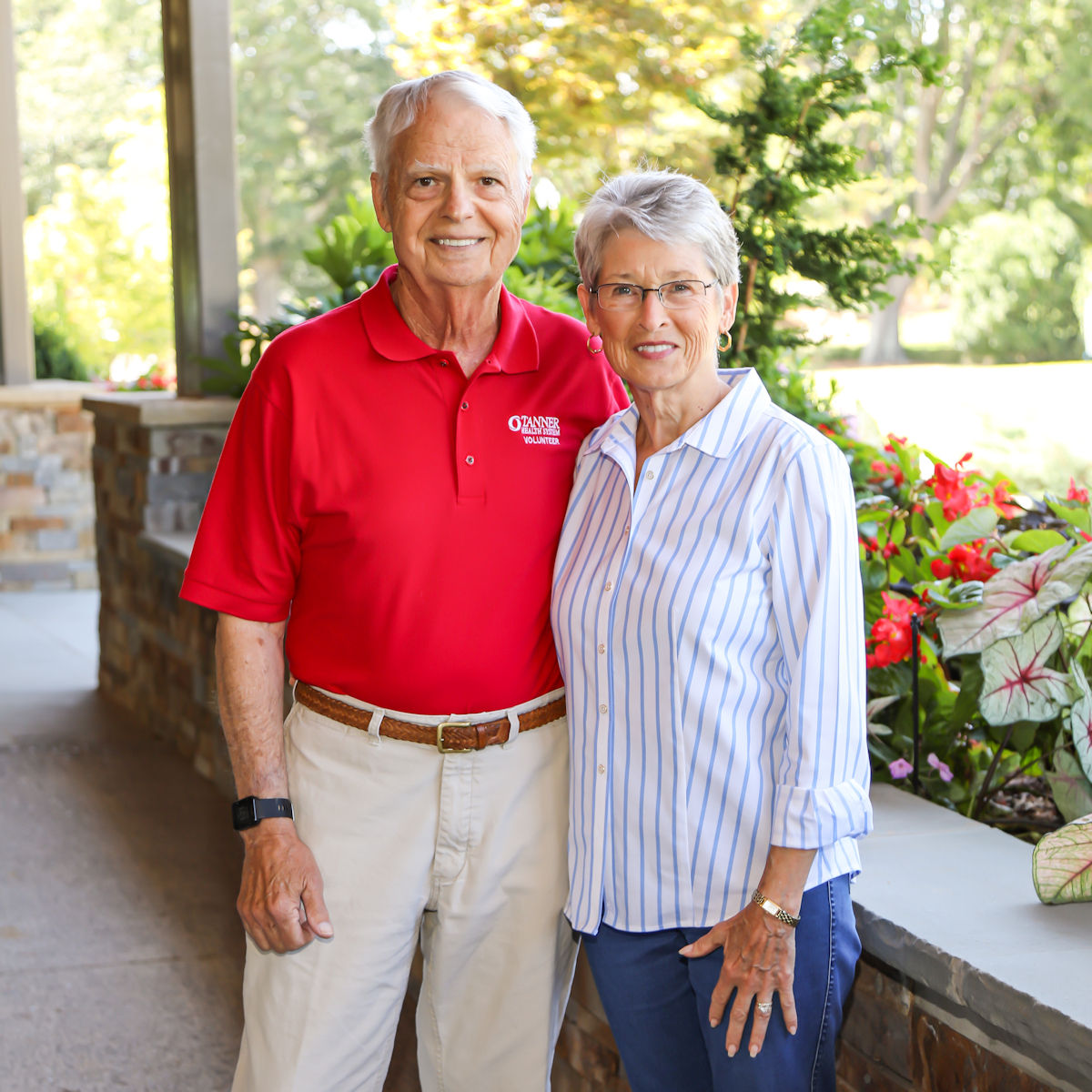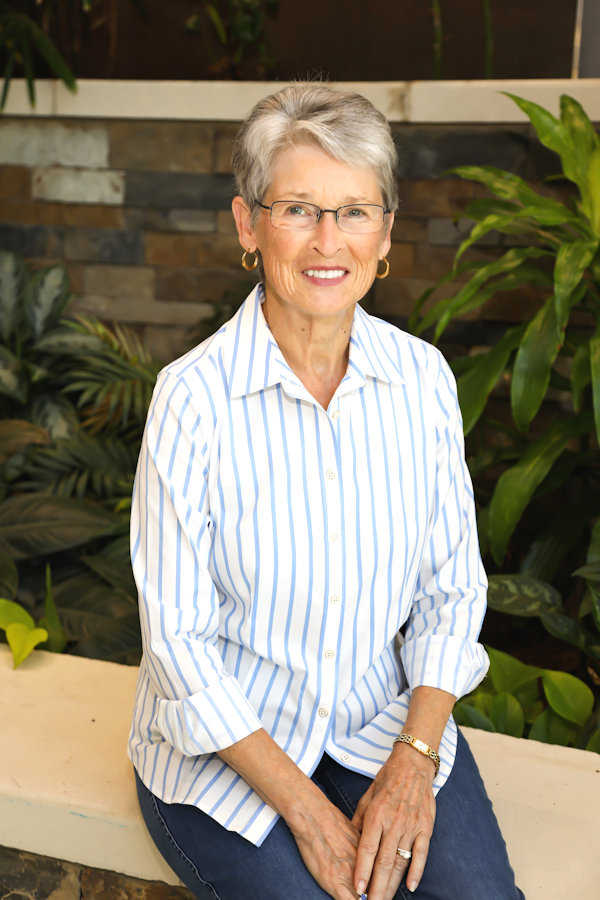When the American Cancer Society issued a plea a few years ago for drivers to transport cancer patients to their treatments, Carrollton resident Fran Robinson volunteered. Then, in January 2022, she became the patient when she was diagnosed with breast cancer.
When she arrived for her first radiation treatment at Tanner’s Roy Richards, Sr. Cancer Center in April, one of the patients she ferried to treatments greeted her in the parking lot bearing a dozen red roses.
It’s been a year of unexpected health challenges for Robinson and her husband, Lacey, both of whom had enjoyed 77 years of good health with virtually no illnesses until her diagnosis and his unexpected quadruple bypass surgery in May.
A lump in the night
 Robinson first detected a lump in her left breast with her hand in the middle of the night — completely by chance — when she turned over in bed.
Robinson first detected a lump in her left breast with her hand in the middle of the night — completely by chance — when she turned over in bed.
“I thought, OK, something’s wrong here,” she said. “It was an unsettling feeling, but I don’t recall being afraid. I went right back to sleep, knowing I’d call my doctor in the morning. I had no breast cancer history in my family, and I knew it would be early stage even if it was cancer. It had only been a year since my last mammogram. It is what it is, and I will do whatever I have to do to take care of it.”
Her next annual screening mammogram was already scheduled for the following week, so her gynecologist switched it to a diagnostic mammogram when Robinson called to report the lump. The mass appeared suspicious during mammography, so an ultrasound was also done on Jan. 25.
Robinson underwent a series of diagnostic tests confirming it was cancer and providing more information to help her physicians determine the type and the best path forward. Tanner breast surgeon Raul Zunzunegui, MD — “Dr. Z” to his patients — at Comprehensive Breast Care Center, also reviewed Robinson’s previous five annual screening mammograms to confirm no evidence of disease.
Another ultrasound and biopsy — including a tissue sample of the mass and the sentinel lymph node, located in the armpit and closest to the mass — followed on Feb. 7. The lymph node was tested to assess the likelihood of spread of the tumor beyond the breast. A mammogram on Feb. 11 aided the placement of a titanium clip to pinpoint the location of the mass. A breast MRI was done on Feb. 18.
Confidence-inspiring care
The Tanner Cancer Care Promise means that within three days of diagnosis, patients will:
- Meet with a team of cancer care specialists
- Get answers to important questions
- Learn about treatment options
- Develop an individualized treatment plan
Physicians determined that Robinson had not just one, but two kinds of breast cancer: invasive lobular carcinoma and ductal carcinoma in situ. She was reassured when Dr. Z said, “That’s OK, we treat both the same way.” He outlined step-by-step what needed to be done.
“I had complete trust in Dr. Z and his staff,” she said.
Robinson and patient navigator Nicolle Rooks, RN, became “phone buddies.”
“Nicolle is fabulous! She called me on a regular basis to see if I was concerned, had any questions about what was happening or what the doctors were doing and to see what else was going on in my life,” said Robinson.
Her first lumpectomy was on March 4 to remove the mass and two lymph nodes to determine if the cancer had spread. She was relieved to learn there was no lymph node involvement. A second lumpectomy on March 25 removed additional tissue to establish clear cancer-free margins around the affected area.
 Pathology of tissue removed during her lumpectomy confirmed her cancers were common types at low risk of reoccurrence, so physicians recommended 24 radiation treatments followed by a daily oral hormone receptor medication, Arimidex, for five years to reduce the chance that cancer cells would clump together and grow.
Pathology of tissue removed during her lumpectomy confirmed her cancers were common types at low risk of reoccurrence, so physicians recommended 24 radiation treatments followed by a daily oral hormone receptor medication, Arimidex, for five years to reduce the chance that cancer cells would clump together and grow.
Following a month of healing from her two lumpectomies, Robinson arrived at the Roy Richards, Sr. Cancer Center on April 26 for her first daily radiation treatment and that bouquet of red roses.
Robinson tolerated those 24 radiation treatments to her left breast very well with no skin blistering and limited peeling, two frequently reported radiation treatment side effects.
“I couldn’t even complain,” she said.
During her radiation therapy, Robinson benefited from a recent innovation at Tanner for women receiving treatment for left breast cancer to protect the heart from a potential side effect of their life-saving radiation treatments: heart damage.
“Women with cancer in the left breast are especially susceptible to heart damage from radiation,” said Anil Dhople, MD, a radiation oncologist and medical director with Tanner Radiation Oncology and quality advisor for Tanner Cancer Care. “With women living longer and longer after breast cancer, a new focus is on preventing long-term damage. It’s unfair for women to survive breast cancer only to suffer the complications from their treatment later in life.”
During deep inspiration breath hold, women are coached to breathe in and hold their breath for about 15 seconds during their radiation treatments. This technique fills the lungs with air, pushing the heart out of the path of the radiation beam.
Radiation oncologists at Tanner use a sophisticated laser grid and multiple optical sensors that supply the radiation therapy equipment with thousands of points of data. Simultaneously and in real-time, they make sure the radiation is targeted right where they want it to go — into the cancerous tissue, not the heart.
“This was fairly new, and that made me feel even better about my care at Tanner,” she said.
Partners in sickness and in health
Two weeks before Robinson completed her radiation therapy, her husband Lacey, was hospitalized unexpectedly for a quadruple bypass.
She applauds Tanner for being so flexible in the coordination of her radiation care so she could visit with her husband daily throughout his surgery and inpatient recovery 90 minutes away. Typically, that meant her own radiation treatment in the mornings and then traveling to his bedside after that.
“After transporting other cancer patients before my own diagnosis, I already knew the Tanner Cancer Care team were wonderful people. My own experience made me even more aware. They were willing to do anything to make my treatments more convenient during his surgery and recovery. They were just as concerned about him and always asked for updates on his progress,” she said.
Following his release and home recovery, he was able to get his cardio rehab at Tanner’s John and Barbara Tanner Cardiac Rehabilitation Center, located in the Tanner Health Pavilion on Dixie Street across from Tanner Medical Center/Carrollton. That was so much easier for the couple. (Starting in January 2023, open heart surgeries such as a quadruple bypass will also be available at Tanner in Carrollton.)
The pair remained one another’s rocks throughout both their health crises.
“After 77 years of virtually no illnesses, we both have had it this year. Thankfully, we were in very good health going into these situations. It’s so important to stay as healthy as you can. We’ve often said that when one of us needed the other, we were there for it. I was almost finished with my health situation when he had his. He’s so like I am. We just deal with it. We talked about the possibilities … a lumpectomy, possibly a mastectomy. Who cares? I will be alive. He was 100% OK with whatever I felt we needed to do,” she said.
Robinson credits her immediate family — son Clint and his wife in Virginia, and son Clay here in Carrollton — their St. Margaret’s church family and their “middle of the night friends” for helping them manage through the challenging days.
“You have to be willing to accept help. Your family and friends want to do something for you. Let them. We depend on one another, and I hope we don’t use up all those good graces. My neighborhood was fabulous. They looked after Lacey and me, asked questions, made meals for us. We ate really well during that time!” she said.
Robinson hopes to be able to return the favors extended to her soon, including resuming providing transportation for other patients and other help.
“A quote from my navigator Nicolle was so true: ‘Eventually you’ll look back at this time as a bump in the road.’ I agree. I am so much more grateful for what I have access to here in Carrollton. I am appreciative of all that has been done to make Tanner Health System what it is. I want to do more for people who are in my situation who might not have the resources I have and are facing a cancer diagnosis,” she said.
Learn more at TannerCancerCare.org.